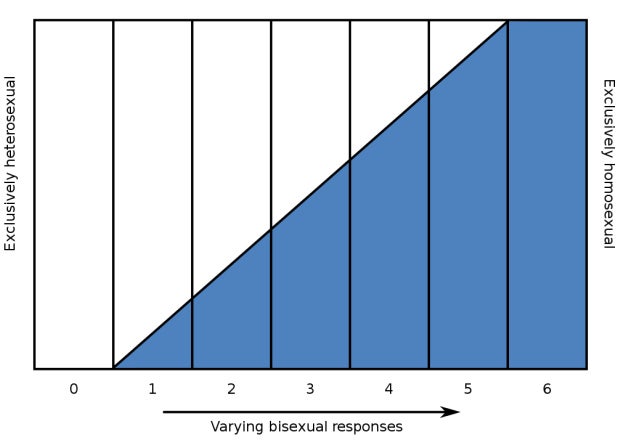What Does It Mean To Be A Heteroromantic Bisexual?
Can you be bisexual and marry someone of the opposite sex?
 Getty
Getty It’s highly agreed-upon that sexuality isn’t just split up into “homosexuality” and “heterosexuality,” as was once thought — and it doesn’t just stop at “bisexuality,” either.
Most experts agree that human sexuality is represented by a spectrum, that the majority of sexually active people fall somewhere in the middle of it. There's even a spectrum of experiences within asexuality. (Asexual people have a low or absent interest in or desire for sexual activity.)
So what is a heteroromantic person?
One aspect of the sexuality spectrum is that of "romanticism."
Someone who identifies as heteroromantic is simply someone who is romantically attracted to a member of the opposite sex or gender.
For example, if you're a man who identifies as heteroromantic, you would be romantically attracted to women. But it doesn't necessarily mean you're sexually attracted to them.
To understand this a little better, let's first discuss the Kinsey Scale.
Developed by Dr. Alfred Kinsey, Dr. Wardell Pomeroy, and Dr. Clyde Martin, The Kinsey Scale, which rates varying sexual attractiveness responses on a 7-point scale, from heterosexuality to homosexuality, seemingly proving that people don't typically fit into exclusive heterosexual or homosexual categories.
Based on this logic, if you're a 3 on the scale, you're bisexual —meaning you're sexually attracted to both men and women.
 Photo: Wikipedia.org
Photo: Wikipedia.org
Unfortunately, the Kinsey scale doesn't measure romantic orientations; therefore, you won't find heteroromantic bisexuals on it.
You could, however, find asexuality, since the doctors included an "X" category where there were no socio-sexual contacts or reactions. But if you're heteroromantic asexual, this scale isn't meant for you either.
What is a heteroromantic asexual?
Speaking of asexuality, a heteroromantic asexual is a person who doesn't experience sexual attraction at all, but does still experience romantic attraction to the opposite gender.
People who identify as heteroromantic asexuals are interested in dating and having a relationship with the opposite gender, but aren't that interested in having sex with them (or anyone).
What does biromantic mean?
Biromantic means you're romantically attracted to people from more than one gender group. Being biromantic also means you might not consider gender identity an important part of romantic attraction.
For example, if you're romantically attracted to both men and women, you can identify as biromantic.
A person can be bisexual and also feel heteroromantic.
Even as new and possibly more complex ideas of sexuality become more accepted in the western world, the residual stains of long-held stigmatization affect the way people view their own orientation.
Some people may have come to accept homosexuality, but don't quite understand bisexuality. They think bisexuals should just "choose" one way or the other.
But for a bisexual — or, similarly, a pansexual — having to "choose a side" feels like being forced to be someone they're not. That's why it's so helpful to add nuance to the sexuality spectrum, including the term "heteroromantic bisexual".
Can you be sexually attracted to a gender but not romantically attracted?
To understand heteroromantic bisexuality, you must first recognize that you can be attracted to someone sexually even if you don't desire them in a romantic way.
Urban Dictionary actually explains it well, saying that a heteroromantic bisexual is "a person who is sexually attracted to both sexes but romantically attracted to only the opposite sex."
The term “bisexual” indicates one’s sexual attraction to both males and females, but in the case of this and other sexual orientations, romance is split into a separate category from sexuality.
Talking about a person's romantic identity covers an array of relationship dynamics, all with one fundamental similarity: a romantic relationship (or willingness to be in one) with a partner of the opposite gender.
In an interview with YourTango, sex educator Dr. Nancy Webb helped explain the difference. When asked if sexual orientations that separate the sexual and romantic aspects stem from the stigma attached to bisexuality and homosexuality, Webb said that her answer would have been “yes” a few years ago, but she has since changed her mind.
“Now, I think it stems more from individuals wanting a label for how they feel,” she stated.
People want to have an identity that isn’t strictly sexual — hence the addition of the "romantic" aspect. They may also want to be more comprehensive with their identity labels, specifying their potential relation to more individuals by expanding the term.
Webb also mentioned that more specific labels of sexuality allow people to feel validated in their identities, adding, “In today’s time, people want relationship labels to relate to their relationship as theirs. The more details used, the more validated a person feels."
And that's a great thing! With so many labels for sexuality, the differences between specific identities become less glaring and more nuanced.
Some people identify as sexually fluid, which indicates a fluctuation of sexual identity.
People who are sexually fluid might use the label "heteroromantic bisexual" during times in their life in which they are in a romantic relationship with someone of the opposite sex, but remain sexually attracted to people of the same sex also.
Another term used is "hetflex" or "heteroflexible," which describes a person who is “mostly straight.” In other words, they commonly find themselves attracted to people of a different gender, but will now and then find themselves attracted to the same gender.
Heteroromantic bisexuality differs from other sexual orientations like demisexuality, too. Dr. Webb described the label and distinguished it from heteroromantic bisexuality, stating that “the demisexual label is the need of the person to be romantically or emotionally involved with the person to be (sexually) attracted.”
This is similar to pansexuality, which describes someone who does not limit themselves sexually according to a potential partner’s biological sex or gender identity. Dr. Webb explains, “Demisexual could be considered, along with pansexual, a precursor to the term ‘heteroromantic.'"
Many people feel confused when confronted with the topic of sexual and romantic identity. They may know how they feel and what they find attractive on the inside, but find it difficult to describe their feelings as a whole.
"Heteroromantic bisexuality" and other similar labels allow people to become familiar with previously unaddressed feelings and attractions without jumping head-on into definitive labels such as “homosexual” or “pansexual,” which may or may not be accurate for the individual.
As the heteroromantic bisexual label gains more traction as a mainstream sexual identity, it is likely that more people will become confident in expressing their sexual identities openly.
Some psychologists and mental health professionals believe that most (if not all) people are not exclusively straight or gay and that a multitude of specific labels allows people to comfortably choose one that fits them best.
In an age in which identity labels and representation matter for those who feel lost or confused, specific labels allow marginalized groups to feel recognized and significant.
Emily Van Devender is a freelance writer and Colorado native who writes about pop culture, astrology, sexuality and relationships.

